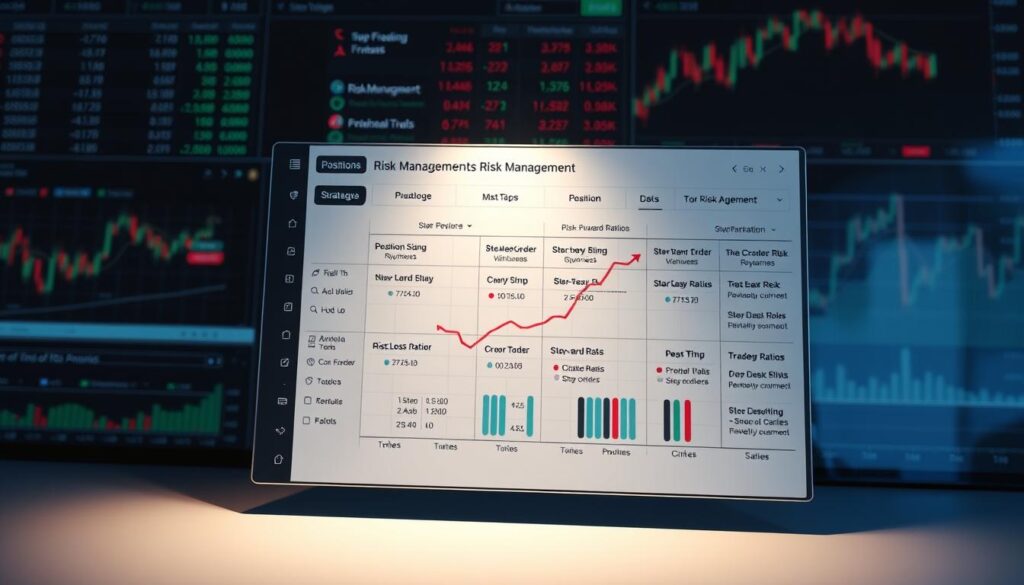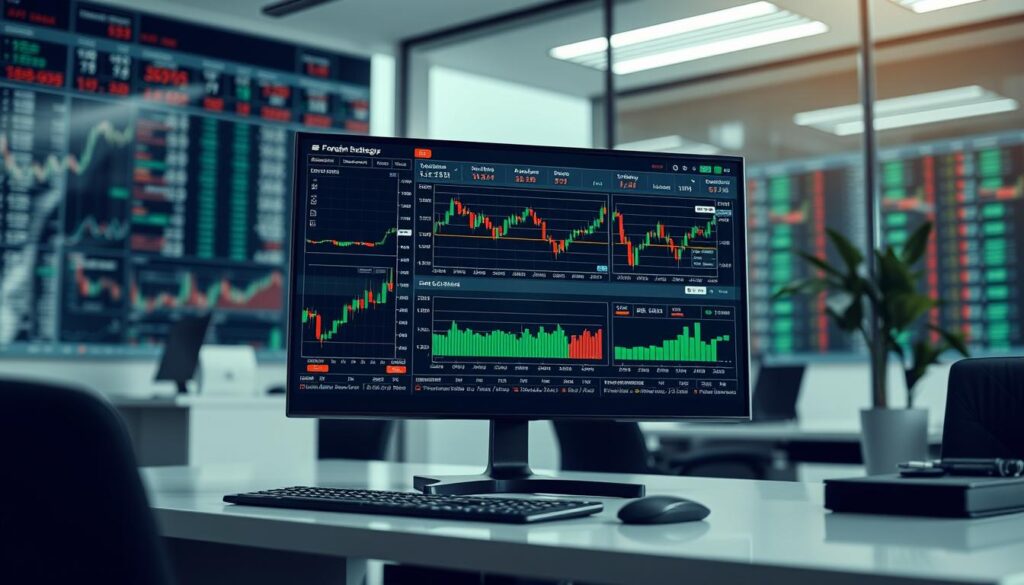Can a well-crafted trading plan really make a difference in the forex market? The answer lies in understanding the right strategies to maximize profits and minimize losses.
Successful traders know that having a solid foundation is crucial. This involves not just understanding market trends, but also being able to analyze and adapt to them effectively.
By exploring effective methods, traders can gain the insights needed to navigate the complexities of the forex market. This article will delve into the essential trading strategies that can lead to success.
Key Takeaways
- Understanding the importance of a well-crafted trading plan.
- Learning effective methods for analyzing market trends.
- Adapting strategies to minimize losses and maximize profits.
- Gaining insights into successful forex trading methods.
- Navigating the complexities of the forex market with confidence.
Understanding Forex Trading Basics
A strong foundation in Forex trading basics is essential for anyone looking to navigate this dynamic market. Forex trading, also known as foreign exchange trading, involves the exchange of one currency for another with the aim of making a profit.
What is Forex Trading?
Forex trading is the act of buying and selling currencies on the foreign exchange market. It’s a global market where individuals, businesses, and institutions trade currencies. The Forex market is the largest financial market in the world, with a daily trading volume exceeding $6 trillion.
The Forex market operates 24/5, meaning it’s open 24 hours a day, five days a week, across major financial centers. This allows traders to react to news and events as they happen, making it a highly liquid and volatile market.
Key Terminology Explained
To navigate the Forex market effectively, traders need to understand key terminology. Terms like pip, leverage, and margin are fundamental. A pip is the smallest unit of price movement in Forex trading, while leverage allows traders to control larger positions with a smaller amount of capital.
Understanding these terms is crucial for developing a trading strategy and managing risk. For instance, knowing how to use stop-loss orders can help limit potential losses.
Importance of Market Analysis
Market analysis is a critical component of successful Forex trading. It involves analyzing market data to predict future price movements. There are two primary types of market analysis: technical analysis and fundamental analysis.
- Technical analysis involves studying charts and patterns to identify trends.
- Fundamental analysis focuses on economic indicators, news, and events that can impact currency prices.
By combining both approaches, traders can make more informed decisions and improve their trading outcomes.
Types of Forex Trading Strategies
To succeed in forex trading, understanding the different types of trading strategies is crucial. The forex market is vast and varied, offering numerous opportunities for traders to profit. However, the key to success lies in selecting a trading strategy that aligns with one’s trading goals, risk tolerance, and market analysis.
Day Trading Strategies
Day trading involves making multiple trades within a single day, with all positions closed before the market closes. This fast-paced trading style requires a deep understanding of market dynamics and the ability to make quick decisions. Day traders often rely on technical analysis and chart patterns to identify trading opportunities.
Effective day trading strategies include scalping, which involves making numerous small trades to capitalize on minor price movements, and range trading, which focuses on trading within established support and resistance levels.
Swing Trading Tactics
Swing trading is a strategy that involves holding positions for a shorter period than investing, but longer than day trading. It typically involves capturing a portion of a potential price move. Swing traders use technical analysis to identify trends and patterns that suggest a potential price swing.
Key swing trading tactics include using indicators like the Relative Strength Index (RSI) and Moving Averages to identify entry and exit points, and being mindful of market news and events that could impact price movements.
Position Trading Approaches
Position trading is a long-term strategy that involves holding positions for extended periods, often weeks or months. This approach requires a deep understanding of fundamental analysis and the ability to withstand market fluctuations. Position traders aim to profit from long-term trends in the forex market.
Successful position trading approaches involve thorough research and analysis of economic indicators, geopolitical events, and market trends. Traders must also be patient and disciplined, as this strategy is not suited for those looking for quick profits.
Technical Analysis in Forex Trading
Technical analysis is a cornerstone of successful forex trading, enabling traders to make informed decisions. By analyzing historical market data, traders can identify patterns and trends that help predict future price movements.
One of the primary tools used in technical analysis is the forex chart. Reading forex charts effectively is crucial for understanding market dynamics. Charts provide a visual representation of market data, making it easier to identify trends, support, and resistance levels.
Reading Forex Charts Effectively
To read forex charts effectively, traders must understand the different types of charts available, such as line charts, bar charts, and candlestick charts. Each chart type offers unique insights into market behavior.
For instance, candlestick charts are particularly popular among forex traders due to their ability to convey detailed information about price movements. By analyzing candlestick patterns, traders can gain insights into market sentiment and potential future movements.
Key Indicators for Traders
In addition to chart reading, key indicators play a vital role in technical analysis. These indicators are mathematical calculations based on historical price data and are used to predict future price movements.
Some of the most commonly used indicators include Moving Averages, Relative Strength Index (RSI), and Bollinger Bands. Each indicator provides unique insights into market trends and potential trading opportunities.
| Indicator | Description | Usage |
|---|---|---|
| Moving Averages | Average price over a specified period | Identifying trends |
| Relative Strength Index (RSI) | Measures the speed and change of price movements | Identifying overbought/oversold conditions |
| Bollinger Bands | Volatility indicator consisting of a moving average and two standard deviations | Identifying volatility and potential breakouts |
Utilizing Candlestick Patterns
Candlestick patterns are a powerful tool in technical analysis, offering insights into market sentiment and potential reversals. Patterns such as the Hammer, Shooting Star, and Engulfing patterns can signal potential trading opportunities.
“The ability to read candlestick patterns is a skill that can significantly enhance a trader’s ability to make informed trading decisions.” – Expert Trader
By combining the analysis of candlestick patterns with other technical indicators, traders can develop a comprehensive understanding of the market and improve their trading strategies.
In conclusion, technical analysis is a vital component of expert forex trading strategies. By mastering the skills of reading forex charts, understanding key indicators, and utilizing candlestick patterns, traders can gain a competitive edge in the forex market.
Fundamentals of Risk Management
Effective risk management is the backbone of successful Forex trading, enabling traders to navigate the volatile market with confidence. By understanding and implementing key risk management strategies, traders can protect their investments and improve their chances of success.
Setting Stop Loss and Take Profit
One of the fundamental aspects of risk management is setting stop loss and take profit levels. A stop loss order automatically closes a trade when the price reaches a certain level, limiting potential losses. On the other hand, a take profit order closes a trade when the price reaches a predetermined level of profit. These tools help traders manage their risk exposure and lock in profits.
For example, a trader buys EUR/USD at 1.1000 and sets a stop loss at 1.0950 and a take profit at 1.1100. If the price drops to 1.0950, the trade is closed, limiting the loss. If it rises to 1.1100, the trade is closed, securing the profit.

Knowing Your Risk Tolerance
Understanding your risk tolerance is crucial in Forex trading. Risk tolerance refers to the amount of risk a trader is willing to take on. It’s influenced by factors such as financial situation, trading experience, and personal comfort with volatility.
“The key is not to predict the market but to manage the risk.” – Anonymous Trader
Traders should assess their risk tolerance and adjust their trading strategies accordingly. This might involve reducing position sizes or avoiding highly volatile currency pairs.
The Importance of Position Sizing
Position sizing is another critical component of risk management. It involves determining the appropriate amount of capital to allocate to a trade. Proper position sizing helps manage risk by ensuring that no single trade exposes the trader to excessive potential loss.
| Account Size | Risk per Trade | Position Size |
|---|---|---|
| $10,000 | 2% | $200 |
| $5,000 | 1% | $50 |
| $20,000 | 3% | $600 |
By mastering these risk management fundamentals, Forex traders can enhance their trading performance and achieve long-term success.
Developing a Trading Plan
Crafting a trading plan tailored to your trading style and goals is a critical step in forex trading. A trading plan serves as a roadmap, guiding your decisions and helping you stay focused on your objectives.
Components of a Successful Trading Plan
A successful trading plan includes several key components. First, it should clearly define your trading goals, whether you’re looking for short-term gains or long-term growth. Second, it should outline your risk management strategy, including how to set stop-loss orders and manage position sizes. Finally, it should detail your entry and exit strategies, based on thorough market analysis.
By incorporating these elements, a trading plan helps traders make informed decisions and avoid impulsive actions based on emotions. It’s essential to regularly review and update your trading plan to reflect changes in market conditions or your personal trading goals.
Setting Realistic Goals
Setting realistic goals is a crucial aspect of a trading plan. Traders should establish clear, achievable objectives, such as daily or monthly profit targets. These goals should be based on a thorough understanding of the markets and your own trading capabilities.
Realistic goals help traders stay motivated and focused. They also provide a benchmark against which to measure performance, allowing for adjustments to the trading plan as needed.
Backtesting Your Strategy
Backtesting is the process of testing a trading strategy using historical data to evaluate its potential performance. This step is vital in developing a trading plan, as it helps traders understand how their strategy would have performed in the past.
By backtesting, traders can identify potential weaknesses in their strategy and make necessary adjustments before implementing it in live markets. This process can significantly enhance the effectiveness of a trading plan and improve overall trading performance.
The Role of Emotions in Trading
Successful trading is as much about mastering emotional control as it is about mastering trading strategies. Emotions play a significant role in trading, influencing decisions and outcomes. Understanding and managing these emotions is crucial for achieving success in the Forex market.
Keeping a Trading Journal
One effective way to manage emotions and improve trading performance is by keeping a trading journal. This involves recording each trade, including the rationale behind it, the outcome, and any emotions experienced during the process. By reviewing this journal, traders can identify patterns in their behavior and make adjustments to improve their decision-making.
For instance, a trader might notice that they tend to make impulsive decisions when they’re feeling anxious. Recognizing this pattern allows them to develop strategies to mitigate its impact, such as taking a break before making a trade or practicing relaxation techniques.
Strategies to Manage Stress
Managing stress is another critical aspect of emotional control in trading. High levels of stress can lead to impulsive decisions, which often result in losses. Traders can employ several stress management techniques, including:
- Meditation and mindfulness practices to calm the mind
- Regular exercise to reduce overall stress levels
- Setting realistic goals and breaking them down into achievable steps
By incorporating these strategies into their daily routine, traders can better manage their stress levels and maintain a clearer, more rational mindset when making trading decisions.
Overcoming Common Psychological Traps
Traders often fall into certain psychological traps that can hinder their performance. Common traps include:
- Confirmation bias: The tendency to seek information that confirms one’s preconceived notions
- Fear of missing out (FOMO): The anxiety that drives traders to make impulsive decisions based on the fear of missing potential gains
- Revenge trading: Attempting to recoup losses by making impulsive trades
To overcome these traps, traders must first become aware of them. By recognizing when they’re falling into these patterns, traders can take steps to correct their behavior, such as taking a step back to reassess their strategy or seeking advice from more experienced traders.

By understanding the role of emotions in trading and implementing strategies to manage them, traders can significantly improve their performance. This involves a combination of self-awareness, discipline, and the right tools, such as a trading journal and stress management techniques. As traders master their emotions, they can make more rational, informed decisions, ultimately leading to greater success in the Forex market.
Utilizing Automation in Forex Trading
Forex traders are increasingly turning to automated trading systems to enhance their trading performance. Automation in forex trading involves using computer programs to automatically execute trades based on predefined rules. This approach can help traders capitalize on market opportunities more efficiently and reduce the emotional stress associated with manual trading.
Benefits of Automated Trading Systems
Automated trading systems offer several key benefits, including the ability to trade around the clock, execute trades at speeds that are not humanly possible, and backtest strategies on historical data. These systems can also help traders stick to their trading plans, avoiding impulsive decisions based on emotions. By leveraging advanced forex strategies, automated systems can optimize trading outcomes.
The use of automated trading systems can significantly enhance a trader’s ability to analyze and respond to market conditions. With the capacity to process vast amounts of data quickly, these systems can identify profitable trades that might be missed by human traders.
Popular Trading Software Options
There are numerous trading software options available to forex traders, each offering unique features and capabilities. Some of the most popular platforms include MetaTrader 4/5, known for their robust functionality and extensive community support. Other notable options include NinjaTrader and TradingView, which offer advanced charting tools and strategy backtesting capabilities. When selecting a trading software, it’s essential to consider the forex trading resources and support provided by the vendor.
- MetaTrader 4/5: Renowned for its user-friendly interface and comprehensive trading tools.
- NinjaTrader: Offers advanced charting and strategy development features.
- TradingView: Provides a wide range of technical indicators and drawing tools.
Risk Factors to Consider
While automated trading systems offer many benefits, there are also risk factors to consider. Technical failures, such as connectivity issues or software bugs, can lead to significant losses if not addressed promptly. Additionally, over-reliance on automated systems can result in a lack of understanding of the underlying trading strategies. It’s crucial for traders to thoroughly backtest their systems and continuously monitor their performance to mitigate these risks.
Traders should also be aware of the potential for over-optimization, where a strategy performs exceptionally well on historical data but fails in live trading. Regular review and adjustment of the trading parameters can help minimize this risk.
Keeping Up with Market News
Keeping abreast of market news enables traders to anticipate and react to market changes. In the fast-paced world of Forex trading, staying informed is crucial for making successful trades. Market news includes a wide range of information, from economic indicators to expert analysis, all of which can impact trading decisions.
Economic Indicators to Watch
Economic indicators are statistical measures that provide insights into the economy’s performance. These indicators can significantly influence currency values and, consequently, Forex trading. Some key economic indicators to watch include:
- Gross Domestic Product (GDP)
- Inflation rates
- Employment rates
- Consumer Price Index (CPI)
Understanding these indicators can help traders predict market trends and make informed decisions.
How to Leverage News Trading
News trading involves making trades based on news events that can impact the market. To leverage news trading effectively, traders should:
- Stay updated with real-time news feeds
- Analyze the potential impact of news on the market
- React quickly to news events
By doing so, traders can capitalize on market volatility and make profitable trades.
Following Expert Analysis and Opinions
Following expert analysis and opinions can provide traders with valuable insights into market trends. Experts often have a deep understanding of the market and can offer predictions based on their analysis. Traders can follow expert opinions through:
- Financial news websites
- Market analysis reports
- Social media platforms
By combining expert insights with their own analysis, traders can develop more effective trading strategies.
Continuous Learning and Improvement
To achieve long-term success in Forex trading, it’s essential to adopt a mindset of continuous learning and improvement. This involves refining your skills, staying up-to-date with the latest market trends, and adapting to new expert Forex trading strategies.
Ongoing Education Resources
Traders can leverage various resources for ongoing education, including online courses, webinars, and trading books. Platforms like Investopedia and FXCM offer valuable insights and tutorials on Forex trading strategies.
Engaging with the Trading Community
Community engagement is vital for traders to share knowledge, learn from others, and stay informed about market developments. Participating in online forums and attending trading seminars can help traders expand their network and gain new perspectives.
Learning from Mistakes
Analyzing and learning from trading mistakes is crucial for improving Forex trading strategies. By keeping a trading journal, traders can identify patterns, refine their approach, and develop more effective strategies.
By focusing on continuous learning and improvement, traders can enhance their skills and stay competitive in the dynamic Forex market, ultimately leading to more effective expert Forex trading strategies.

